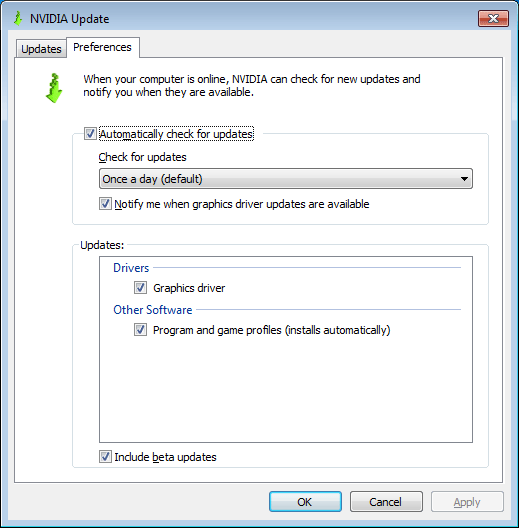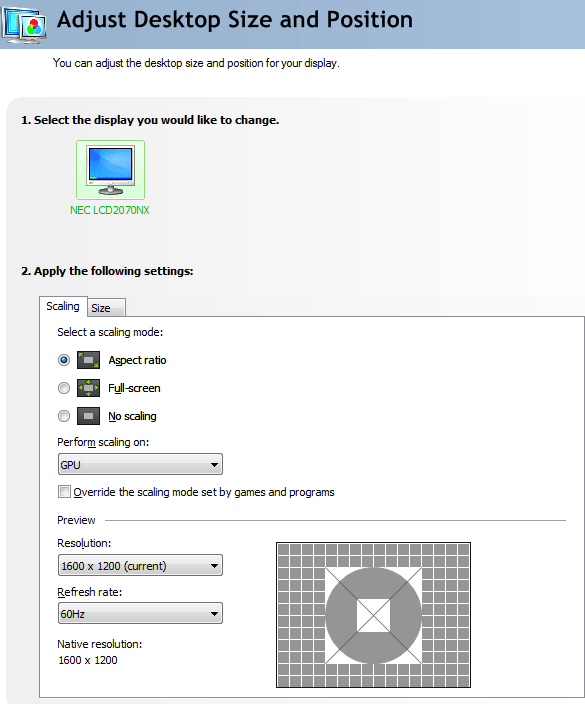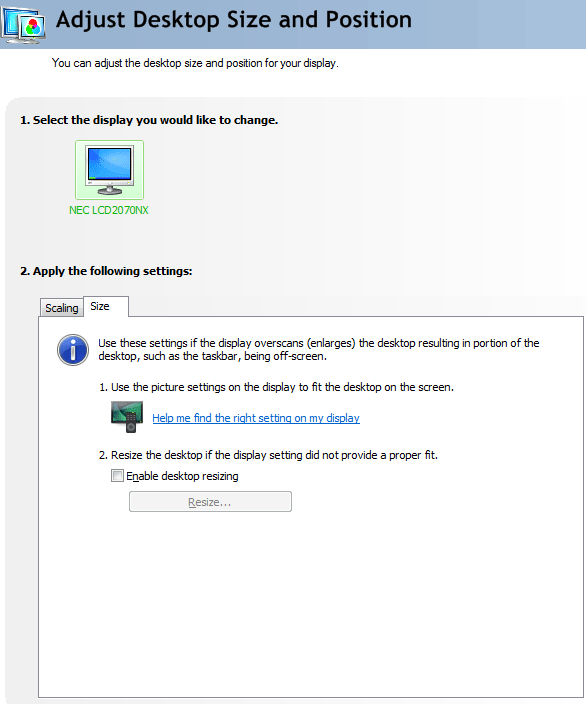NVIDIA's GeForce GTX 560: The Top To Bottom Factory Overclock
by Ryan Smith on May 17, 2011 9:00 AM ESTNew Release 275 Drivers & The Test
Launching alongside the GTX 560 will be the newest branch of NVIDIA’s GeForce drivers: Release 275 beta. This actually comes hot on the heels of Release 270, which came out only a month and a half ago.
Unlike Release 270 NVIDIA isn’t making a lot of performance promises, so this is mostly a feature release. The big item in 275 for most gamers will be further refinements to the auto-update mechanism first introduced in 270. NVIDIA has finally fully ported over Optimus’ auto-update feature, meaning that NVIDIA’s drivers can now automatically find and install profile updates in the background. However whereas Optimus profile updates were necessary for switchable graphics, for desktop users the primary purpose of auto-updating profiles is for SLI and anti-aliasing compatibility, as NVIDIA uses compatibility flags in their profiles to make those features work.

Automatic profile updates won’t completely absolve SLI from periods of incompatibility, but it should help. NVIDIA has released out of band profile updates for SLI before, but these were rather rare. If they now release profile updates much more frequently, then this will be a boon for SLI users, particularly GTX 295/590 users. Otherwise SLI is mostly limited by what can be done with a profile – if NVIDIA has to update the driver itself, then users will still need to wait for a new driver release. Which on that note, NVIDIA hasn’t changed the auto-update procedure for the drivers: profiles will auto-download and install, but driver updates must still be manually approved.
NVIDIA tells us that in the future they will also be able to deliver 3D Vision compatibility updates with profiles, but this will probably require a bit of a rearchitecting to their drivers and profiles. Currently NVIDIA’s profiles contain a few flags for 3D Vision (mainly whether it’s allowed), but there aren’t any sweeping compatibility bits as there are for SLI and AA.
Moving on, the other big functionality update with 275 is a new resizing and scaling UI in the NVIDIA control panel. The core functionality of scaling hasn’t changed much as NVIDIA has offered these controls for quite some time, but now scaling controls are available for VGA and HDMI displays, versus just DVI and DisplayPort as it was previously. There’s also a new override option or Windows 7, for forcing misbehaving programs to use NVIDIA’s scaling options instead of their own. (Ed: We’ve never actually encountered this before. If you know of any games/applications that need this option, please let us known in the comments)

As for resizing, NVIDIA has tweaked the UI to help better guide users through using overscan correction and/or disabling overscan on their TVs. The ideal method of dealing with overscan is to disable it on the TV (thereby ensuring 1:1 pixel mapping), which is what NVIDIA now first directs users toward. For users that can’t disable overscan, they can then unlock NVIDIA’s resizing controls. NVIDIA tells us that they’ve also done some work to improve resizing compatibility for games/applications that try to force standard resolutions, but we have not had an opportunity to test this yet.

The Release 275 betas should be available later today, with WHQL drivers appearing within a month.
The Test
As we mentioned in our introduction, the lack of any reference-clocked cards means that the GTX 560’s clocks – and thereby the GTX 560’s performance – is not well rooted. As a result we’ve tested our ASUS GTX 560 DirectCU II Top at a few different clockspeeds. We’ve tested the card at NVIDIA’s reference clocks of 810/4004 (GTX 560 Base), along with the slowest "mid-grade" card on NVIDIA’s release list: 850/4104 (GTX 560 Mid). NVIDIA is pitching the GTX 560 as their $199 card, so for the purposes of our review we’ll be focusing primarily on the mid-clocked GTX 560, as this is the approximate speed of most of the $199 cards. If you buy a $199 GTX 560 today, this should closely represent the speed of the card you’re buying.
Ideally 810/4004 cards will be relegated to the OEM market, but if not we also have the base clocks included for appropriate consideration. It goes without saying that we’d rather NVIDIA just create two different product lines rather than having so many cards under the same umbrella, but at this point we’re just repeating ourselves.
We’ve also included our overclocking results with the ASUS GTX 560 DirectCU II Top, colored in orange. As we were only able to reach 950/4400, the performance gains are limited.
For drivers, on the NVIDIA side we’re using 275.20 beta for the GTX 560, the GTX 460 1GB, and GTX 560 Ti. In practice the average performance difference between release 275 and release 270 is around 1% in favor of 275. On the ATI side we’re using the Catalyst 11.5a hotfix; however do note that in our testing we’ve found that performance is identical to the 11.4 drivers.
| CPU: | Intel Core i7-920 @ 3.33GHz |
| Motherboard: | ASUS Rampage II Extreme (X58) |
| Chipset Drivers: | Intel 9.1.1.1015 (Intel) |
| Hard Disk: | OCZ Summit (120GB) |
| Memory: | Patriot Viper DDR3-1333 three x 2GB (7-7-7-20) |
| Video Cards: |
AMD Radeon HD 6970 AMD Radeon HD 6950 2GB AMD Radeon HD 6870 AMD Radeon HD 6850 AMD Radeon HD 5870 AMD Radeon HD 5850 AMD Radeon HD 5770 AMD Radeon HD 4870 NVIDIA GeForce GTX 580 NVIDIA GeForce GTX 570 NVIDIA GeForce GTX 560 Ti ASUS GeForce GTX DirectCU II Top NVIDIA GeForce GTX 550 Ti NVIDIA GeForce GTX 480 NVIDIA GeForce GTX 470 NVIDIA GeForce GTX 460 1GB NVIDIA GeForce GTS 450 NVIDIA GeForce GTX 285 NVIDIA GeForce GTX 260 Core 216 |
| Video Drivers: |
NVIDIA ForceWare 262.99 NVIDIA ForceWare 270.51 Beta NVIDIA ForceWare 275.20 Beta AMD Catalyst 10.10e AMD Catalyst 11.4 AMD Catalyst 11.5a |
| OS: | Windows 7 Ultimate 64-bit |










66 Comments
View All Comments
Ryan Smith - Tuesday, May 17, 2011 - link
In this case we only had the single card.buildingblock - Tuesday, May 17, 2011 - link
My local hardware dealer has the new 560 (non-Ti) in stock today. True, only two models so far but the cheapest 560 in stock costs less than the cheapest 6870 in stock, and even less than some of the 6850s. And that's the issue, graphics cards are about price points. Its no good going on about the AMD 6950 to buyers who are only looking at choosing either a 560 or a 6870, because both are around the same price point. And as already said, the 560 today is actually at a better price point at this dealer than any 6870.One reason why the majority of discrete desktop graphics card buyers continue to purchase nVidia is the quality of the drivers. Or the continuing issues with AMD drivers. There is an example here http://forum.team-mediaportal.com/746244-post1.htm... of a guy who's having problems rendering a web page with a 6950. Yes, that's right a web page, now don't going playing games with it will you.... What he is seeing is partly because the page has a Shockwave slideshow. He complains that GPU usage constantly fluctuates between 0-8-18-44%, with a 6950. With a GTX 550 Ti GPU usage figures 0-2-11% - that's right only 11% with a GTX 550 Ti compared to 44% with an AMD 6950.
That's AMD drivers for you.
DanNeely - Tuesday, May 17, 2011 - link
Meh. That's not a real issue, as can be seen by the replies. Following up on it I'd speculate that the only reason the single time sample spikes at high load are spotted at 175mhz but not at 450 is that at the latter the render takes significantly less than the sample time so they get largely smoothed into the average (as can be seen by the smaller load spikes).There is one real issue in their drivers that's been annoying me significantly since I got my 5870 last summer. When running 2 monitors and a GPU app, when the app completes a work unit it drops down to single monitor speed for a second or three and ghost images from the top of one monitor flicker on the 2nd until the new task starts and the clocks throttle back up. I've made it go away by creating a profile and manually editing its config file so that the single monitor settings (which it enters despite 2 attached monitors) are no lower than the others. This makes the problem go away, but really...
ratbert1 - Tuesday, May 17, 2011 - link
I suggest reading more than one review before deciding which card is better. I do not get the same results as Anandtech does on the same benchmarks. I have a different platform and get different results. Their bench is useful for getting a rough idea, but there are a lot of other sites to check. Not all show the same AMD scores gotten here.I have tried to use AMD cards in the past. I really have, but with a 5850 I could not get it to work with a DVI connection, and with a 3450 it would bluescreen whenever I played a DVD. Both were sent back. All the other cards I have had (Nvidia) just worked!
I even recently looked at getting a 6950, but too many comments on Newegg were about the lousy drivers(too many for me anyway). I just couldn't do it.
L. - Wednesday, May 18, 2011 - link
Well, there's a fair chance your local hardware dealer sucks, as do all local hardware dealers.Get on the web man, its 2011.
At least you'll get to choose your brand and model for realz ;)
jiffylube1024 - Tuesday, May 17, 2011 - link
The GTX 460, ATI 6850 and 6870 are all still quite solid cards, and these charts prove it. Anyone with a GTX 460 (1GB) that overclocked it to 800-850 MHz basically has a GTX 560.It's nice to see the GTX 560 pushing the GTX 560 series at/under $200.
-----
I'm impressed with how much the 6870 has improved versus the 5870. When the 6870 came out, it was basically trumped by the 5870 in everything; now, if anything, the 6870 comes out a bit faster.
marc1000 - Tuesday, May 17, 2011 - link
you meant "The GTX 460, ATI 5850 and 5870 are all still quite solid cards"?because 6850 and 6870 are current-gen....
marc1000 - Tuesday, May 17, 2011 - link
Now I can not say to a friend "buy the GTX 560" when he asks if this card if better or equal to R6950. because he will probably buy the cheapest one, wich will have the SAME name, but is slower.ATI/AMD naming is bad, but Nvidia is worse!
LOL_Wut_Axel - Tuesday, May 17, 2011 - link
I don't know where you guys are getting this information, but the Radeon HD 6870 IS NOT at $180. Therefore, you shouldn't let that sway your opinion about this card. The Radeon HD 6870 is a $200 card, as is the GTX 560. Folders and gamers should go for the GTX 560, while people that want higher efficiency and same performance should go for the Radeon HD 6870.That alone leaves me with a very bad taste about this article. I suggest you read the review by Tom's Hardware and TechPowerUp instead.
starfalcon - Tuesday, May 17, 2011 - link
A 6870 can hit $170 on Newegg with a rebate, but $192 or so does seem to be the lowest without any rebates.